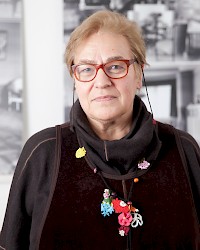Vita
Iris Tzachili, archaeologist and historian, is Emeritus Professor of Prehistoric Archaeology at the University of Crete. There, Tzachili worked as Professor at the Department of History and Archaeology from 1994 to 2011, where she directed several research groups that centred on the technology and history of the textile. She is Director of the Centre for Research and Conservation of Archaeological Textiles (ARTEXT), a research group based in Athens that promotes the study of textile remains and the textile production cycle. Tzachili is also editor of Arachne. She was regional coordinator in the research programme “Clothing and Identities New perspectives on textiles in the Roman empire (DressId)”, funded by the European Union. Tzachili presently co-directs an excavation on the Minoan Peak Sanctuary of Vrysinas in Crete. Her continuous research in the field of textile techniques and the remains of tools, strings and nets has led to numerous publications that engage in a dialogue with art history, archaeology and cultural history.
Dated from 2015
IKKM Forschungsprojekt
Minoan Peak Sanctuaries: finding a frame for thousands of broken figurines in an open air cult place
The setting
In some high places in the mountains in Crete in a relatively small area (3 or 4 square kilometers) thousands of broken figurines as well as broken pottery are found smashed and squeezed together. It is an exceptional phenomenon often far away from settlements and often in the middle of shepherd’s paths. They are usually considered as a cult place, and their chronological span is between 1800 BC to 1500 BC. Apart from cult places, the Minoan peak sanctuaries could be also a collective meeting place with political connotations. In a place that could be seen from far away, different clans met, some kind of decision making took place regarding matters of common interest about pasture lands perhaps, or access to the waters, ceremonies of alliances, confirmation of identities, marriages and so on. A kind of early amphiktyonia. The proposed research evolves around one of these peak sanctuaries named Vrysinas in the Rethymnon region.
During the period of dense activity of the peak sanctuaries the principal evolution in Crete was the process of urbanization, the transformation of small nets of settlements into bigger ones and then into towns. When big towns appeared with strong administrative structure, followed by state formation, the peak sanctuaries declined, as if their functions were no longer necessary in the country and transferred to cities.
Practically all this was followed by common meals and drinks of which we have direct evidence through archaeological data, mostly the pottery fragments. In the moment I have completed the work about pottery and the history of the place and start the work with the figurines.
Specific research topics
For this semester in the IKKM my research will focus on anthropomorphic figurines following the guidelines exposed below.
A. The ceramic figurines are considered in the bibliography to be votive offerings. The research will address the ever-present question of what this really means. What could these hundreds and hundreds of very primitive simulacra of the human form mean? What does this explosion of small female and male figurines rendered in a codified way in three dimensions mean? The phenomenon is the beginning of the big diffusion of manufactured objects in human forms in small communities.
1.1. Other questions are if they are meant to be isolated or to be in groups implying some frame in both cases. The overwhelming numbers could form a mutual frame.
2.2. The actual frame, that is what we see now, is the mountain scenery. But the scale is so different that hypotheses of various positions are difficult. One must suppose some kind of symbolic frame.
B. The conceptual frame.
1.1. The construction of the body and head in the practical as well as the intellectual way. The actual mode of construction follows the intellectual perception of the human body. The same is perceptible through the dress code and the gestures. This look for the essential (versus naturalism) reflects collective values and unified perceptions of life.
C. From construction to deposition. The actual biography of these objects.
D. The historical level and the final question. Are we entitled to look for the reason, is it possible to construct a hypothesis for the extraordinary fact of these figurines or should we restrict ourselves in a description and confirmation?
Publikationen
Monographien
Οι αρχές της Αιγαιακής Προϊστορίας. Οι ανασκαφές στη Θήρα και τη Θηρασία τον 19. αιώνα (The beginnings of Aegean Prehistory. Excavations of the 19th century Thera and Therasia). Athens: Kathimerini 2006.
Υφαντική και υφάντρες στο προιστορικό Αιγαίο (Weaving and weavers in prehistoric Aegaeum). Crete: University Press of Crete 1997.
Herausgaben
with Eleni Zimi: Textiles and dress in Greece and the Roman East: A technological and sociological approach. Athens: Ta Pragmata 2012.
Artikel
“Webkunst und Kleiderproduktion als Tätigkeit der Frau im Griechenland der Römerzeit”. In: Michael Tellenbach, Regine Schulz, Alfried Wiezorek (eds.): Die Macht der Toga. DressCode im Römischen Weltreich. Regensburg: Schnell & Steiner 2013, pp. 115-119.
“The myth of Arachne and weaving in Lydia”. In: Iris Tzachili, Eleni Zimi (eds.): Textiles and dress in Greece and the Roman East: A technological and sociological approach. Athens: Ta Pragmata 2012, pp. 131-144.
with Joanna Smith: “Cloth in Crete and Cyprus”. In: Gerald Cadogan, Maria Iacovou, Katerina Kopaka, James Whitley (eds.): Parallel Lives. Ancient Island Societies in Crete and Cyprus (=British School at Athens Studies, 20). London: Short Run Press 2012, pp. 141-157.
“Weaving at Akrotiri, Thera. Defining cloth-making activities as a social process in a late Bronze Age Aegean town”. In: Carole Gillis, Marie-Louise Nosch (eds.): Ancient Textiles. Production, craft and society. Oxford: Oxbow books 2007, pp. 190-196.
“Anthodokoi talaroi: The baskets of the crocus-gatherers from Xeste 3, Akrotiri, Thera”. In: Lyvia Morgan (ed.): Aegean Wall Painting: A tribute to Mark Cameron (=British School at Athens Studies, 13). London: Short Run Press 2006, pp. 113-117.
“Excavations on Thera and Therasia in the 19th century: A chronicle”. In: Journal of Mediterranean Archaeology 18/2, 2005, pp. 231-257.
